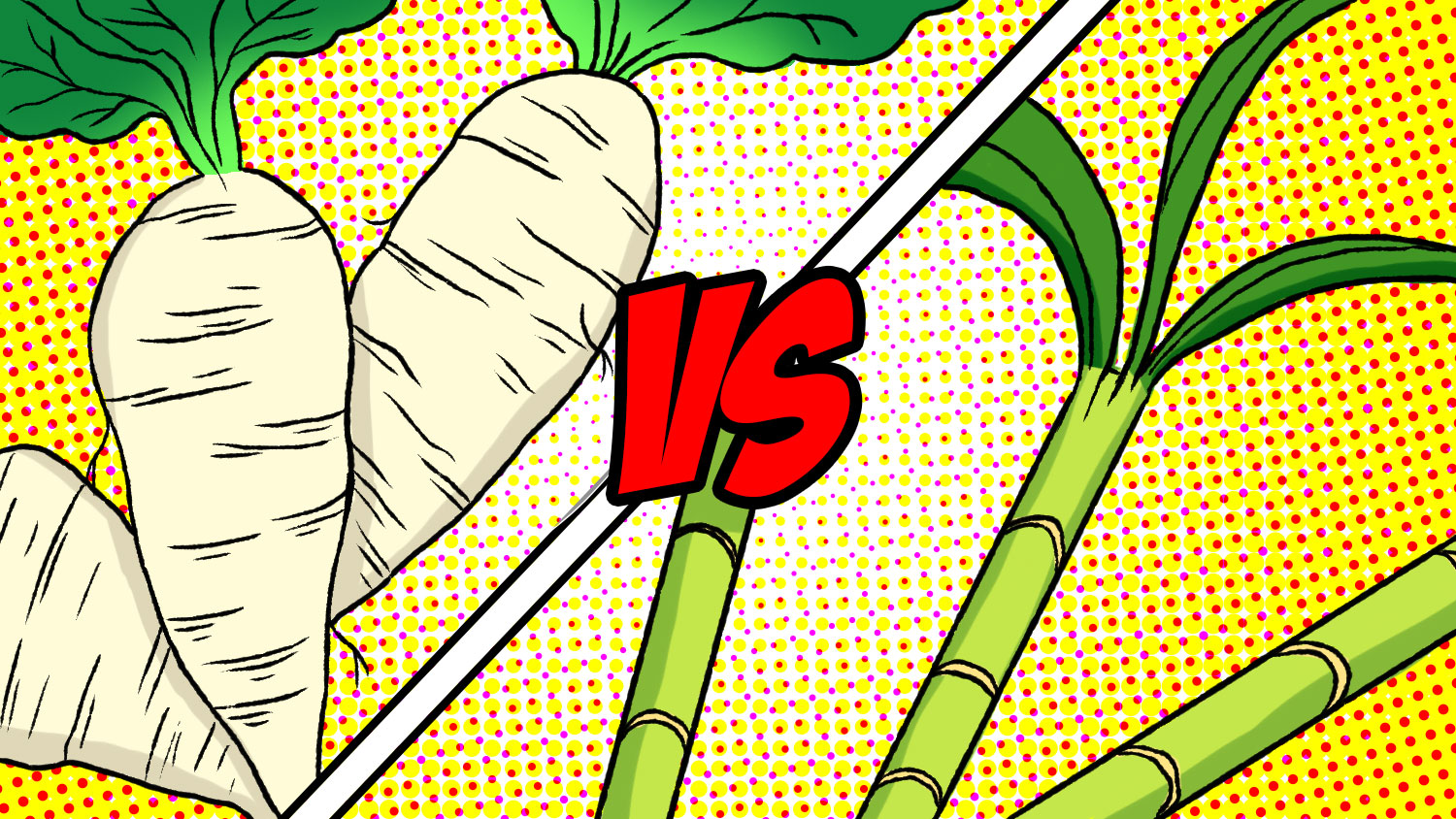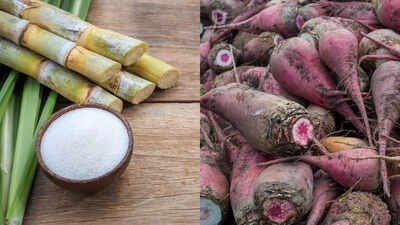Ways to determine between Sugar beet vs sugar cane for your culinary needs
Comprehending Sugar Beet Vs Sugar Cane: a Deep Dive Into Their Handling and Applications
The comparison in between sugar beet and sugar cane reveals vital distinctions in their handling and usage. Each crop has distinct growing approaches that affect its geographic circulation. Sugar beets are largely refined right into granulated sugar for different foodstuff, while sugar cane is often made use of in drinks. Comprehending these differences clarifies their duties in the food market and their economic importance. The wider effects of their farming and handling necessitate more exploration.
Summary of Sugar Beet and Sugar Cane
Sugar beet and sugar cane are 2 main resources of sucrose, each contributing substantially to the global sugar supply. Sugar beet is a root vegetable, generally gathered in cooler climates, while sugar cane is a tall yard that prospers in warmer tropical and subtropical regions. The handling of sugar beet entails washing, cutting, and extracting juice, followed by purification and crystallization. On the other hand, sugar cane processing consists of squashing the stalks to extract juice, which is after that cleared up and focused into sugar crystals.
Both crops are rich in sucrose, yet their structure differs somewhat, with sugar cane normally having a higher sugar content. Each resource also plays a role in biofuel manufacturing, with sugar beet typically used for ethanol. While both are crucial for different applications, their distinctive growth requirements and handling techniques affect their respective payments to the sugar market.
Geographic Distribution and Cultivation Problems
Sugar beet and sugar cane are grown in unique geographical regions, affected by their particular environment and dirt needs. Sugar cane flourishes in tropical climates, while sugar beet is better fit for warm zones with cooler temperature levels. Understanding these cultivation conditions is important for enhancing manufacturing and guaranteeing quality in both plants.
Worldwide Expanding Areas
While both sugar beet and sugar cane are important sources of sugar, their worldwide growing areas vary substantially due to climate and dirt needs. Sugar beet flourishes mainly in warm areas, with substantial production concentrated in Europe, The United States And Canada, and components of Asia. These areas typically include well-drained, productive soils that sustain the crop's development cycle. On the other hand, sugar cane is largely grown in exotic and subtropical regions, with significant production centers situated in Brazil, India, China, and Thailand. This plant flourishes in cozy, humid environments that promote its growth. The geographical circulation of these 2 crops highlights the versatility of sugar cane to warmer environments, while sugar beet remains dependent on cooler, pleasant problems for peak growth.
Climate Needs
The environment demands for sugar beet and sugar cane vary noticeably, mirroring their adaptation to distinct environmental problems. Sugar beet grows in pleasant climates, calling for cool to moderate temperatures, ideally varying from 15 ° C to 20 ° C. It is delicate to frost and take advantage of well-distributed rains during its growing season. This crop is generally grown in areas such as Europe and The United States And Canada.
Alternatively, sugar cane flourishes in tropical and subtropical climates, favoring warmer temperature levels in between 20 ° C and 30 ° C - Sugar beet vs sugar cane. It needs plentiful sunshine and consistent rainfall, making it fit to locations like Brazil, India, and Southeast Asia. The contrasting environment preferences of these crops visibly affect their geographic circulation and farming practices
Soil Preferences
Both sugar beet and sugar cane require particular dirt conditions to grow, their choices differ significantly. Sugar beets prosper in well-drained, loamy dirts rich in raw material, with a pH ranging from 6.0 to 7.5. These conditions are normally discovered in warm regions, especially in Europe and North America. In contrast, sugar cane chooses deep, fertile dirts with superb drainage and a slightly acidic to neutral pH (6.0 to 7.0) This crop is mainly grown in exotic and subtropical environments, such as Brazil, India, and Australia. The geographic circulation of these crops reflects their soil preferences, as sugar beetroots are matched for cooler climates, while sugar cane prospers in warmer, much more moist atmospheres.
Harvesting and Handling Techniques
In checking out the harvesting and processing methods for sugar beet and sugar cane, distinctive techniques arise for every crop. The contrast of gathering techniques exposes variants in efficiency and labor needs, while removal methods highlight distinctions in the initial handling stages. Additionally, understanding the refining procedures is vital for reviewing the quality and yield of sugar generated from these 2 sources.
Collecting Techniques Contrast
When taking into consideration the harvesting techniques for sugar beet and sugar cane, distinct strategies arise that mirror the one-of-a-kind characteristics of each plant. Sugar beet collecting generally includes mechanical techniques, using specialized farmers that root out the beetroots from the ground, removing tops and dirt while doing so. This technique permits effective collection and reduces plant damage. On the other hand, sugar cane harvesting can be either manual or mechanical. Manual harvesting involves employees reducing the stalks short, while mechanical harvesting utilizes big devices that reduced, cut, and collect the cane in one procedure. These differences in harvesting methods highlight the adaptability of each plant to its expanding atmosphere and the farming methods widespread in their respective regions.
Removal Strategies Introduction
Removal strategies for sugar production vary substantially in between sugar beet and sugar cane, mirroring their distinct qualities and processing requirements. Sugar beetroots are normally read this collected using mechanical farmers that cut the origins from the ground, followed by cleaning to eliminate soil. The beetroots are after that sliced into slices, referred to as cossettes, to assist in the removal of sugar through diffusion or warm water removal. On the other hand, sugar cane is usually collected by hand or maker, with the stalks reduced close to the ground. After harvesting, sugar cane undergoes crushing to extract juice, which is then clarified and concentrated. These removal techniques highlight the distinct techniques used based upon the source plant's physical characteristics and the preferred performance of sugar extraction.
Refining Processes Explained
Refining procedures for sugar from both sugar beet and sugar cane include a number of crucial steps that ensure the final product is pure and suitable for intake. At first, the raw juice extracted from either source goes through clarification, where pollutants are eliminated making use of lime and warm. Following this, the juice is evaporated to focus the sugars. For sugar beetroots, the procedure frequently includes carbonatation, while sugar cane might go through an extra uncomplicated condensation technique. Once concentrated, the syrup undergoes crystallization, producing raw sugar. Finally, the raw sugar is purified via centrifugation and more refining, resulting in the white granulated sugar commonly located on store racks. Each step is critical in making certain item quality and safety for consumers.
Nutritional Profiles and Health Impacts

Health effects linked with both sources largely originate from their high sugar content. Extreme usage of sucrose from either source can result in weight gain, dental problems, and boosted danger of chronic conditions such as diabetes and heart problem. However, sugar cane juice, commonly eaten in its natural form, may offer added anti-oxidants and phytonutrients compared to polished sugar beet items. Ultimately, small amounts is crucial in using both sugar beet and sugar cane in diet plans to mitigate possible wellness threats.
Economic Importance and Worldwide Production
The financial value of sugar beet and sugar cane is significant, because both plants play vital duties in the international agricultural landscape. Sugar cane, mainly grown in tropical and subtropical regions, accounts for roughly 75% of the globe's sugar manufacturing. Countries like Brazil and India are leading producers, adding significantly to their national economies via exports and regional consumption.

The worldwide sugar market is valued at billions of dollars, influenced by numerous aspects including climate, trade plans, and customer need. Accordingly, both sugar beet and sugar cane are important for economic stability and development within the farming field worldwide.
Applications in the Food Industry
In the food market, sugar beet and sugar cane offer important duties, providing sugar that are important to a broad array of products. Both sources generate granulated sugar, which is a key component in baked goods, drinks, and confections. Sugar beet, typically favored in regions with colder climates, is frequently discovered in refined foods such as jams, jellies, and dairy products. At the same time, sugar cane is preferred in exotic regions and is frequently used in beverages like rum and soft Get More Information drinks.
Beyond granulated sugar, both sources are likewise processed right into molasses, syrups, and various other sugar, enhancing taste profiles and enhancing structure in numerous applications. Furthermore, the spin-offs of sugar production, such as pulp and bagasse, are used in creating animal feed and biofuels, further demonstrating their adaptability. On the whole, sugar beet and sugar cane are vital elements of the food industry, affecting preference, texture, and total product quality.
Environmental Factors To Consider and Sustainability
As problems regarding environment modification and source deficiency expand, the ecological influence of sugar beet and sugar cane farming has view it now come under scrutiny. Sugar cane, typically grown in exotic areas, can lead to logging and habitat loss, intensifying biodiversity decrease. Additionally, its cultivation regularly relies upon intensive water usage and chemical plant foods, which can contaminate regional waterways.
Alternatively, sugar beet is normally expanded in pleasant environments and may advertise soil health and wellness through crop turning. Nonetheless, it also faces difficulties such as high water intake and dependence on chemicals.
Both plants add to greenhouse gas discharges during processing, but sustainable farming methods are emerging in both fields. These include accuracy farming, chemical-free farming, and incorporated bug monitoring. In general, the environmental sustainability of sugar manufacturing remains a pushing concern, requiring continuous analysis and adoption of environmentally friendly methods to alleviate adverse effects on communities and areas.

Regularly Asked Questions
What Are the Distinctions in Taste In Between Sugar Beet and Sugar Cane?
The preference differences in between sugar beet and sugar cane are subtle yet distinctive. Sugar beet often tends to have a somewhat earthier taste, while sugar cane supplies a sweeter, a lot more aromatic account, interesting numerous cooking preferences.
Can Sugar Beet and Sugar Cane Be Made Use Of Mutually in Recipes?
Sugar beet and sugar cane can commonly be made use of mutually in dishes, though subtle differences in flavor and structure might occur. Substituting one for the various other usually maintains the desired sweetness in cooking applications.

What By-Products Are Created From Sugar Beet and Sugar Cane Processing?
The handling of sugar beets and sugar cane returns numerous byproducts. These include molasses, pet feed, and biofuels. Each spin-off offers distinctive objectives, adding to agricultural and industrial applications beyond the key sugar extraction.
How Do Sugar Beet and Sugar Cane Affect Dirt Health And Wellness?
The effect of sugar beet and sugar cane on soil health differs; sugar beetroots can boost organic matter, while sugar cane might lead to soil deterioration if not taken care of appropriately, influencing nutrient levels and dirt framework.
Exist Certain Ranges of Sugar Beet and Sugar Cane?
Various details ranges of sugar beet and sugar cane exist, each adjusted to different environments and dirt kinds. These varieties are cultivated for characteristics such as return, disease resistance, and sugar web content, optimizing farming productivity.